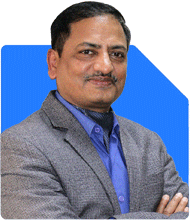Ramalingam Kalirajan |10872 Answers |Ask -Follow
Mutual Funds, Financial Planning Expert - Answered on May 17, 2024
He has an MBA in finance from the University of Madras and is a certified financial planner.
He is the director and chief financial planner at Holistic Investment, a Chennai-based firm that offers financial planning and wealth management advice.... more

Sir, I am 55 years. I started investing since last two years back due to family responsibilities. Now I am investing in (1)HDFC Midcap opportunities fund RS 5000 (2)Mirae asset large cap and mid cap fund RS 5000 (3)Nippon India Small Cap Rs 8000 (4)Parag Parikh flexicap fund RS 2000. Request you to suggest me.
Your current investment portfolio showcases a diverse mix of funds, which is commendable. Starting late due to family responsibilities is common, and you have done well to begin investing for your future. Let's evaluate your portfolio and provide some insights for improvement.
Midcap Fund Investments
Midcap funds offer a balance between risk and return. They have the potential for higher growth compared to large-cap funds but come with greater volatility. Investing a significant portion in midcap funds can yield substantial returns if held over the long term. However, consider the associated risks and ensure this aligns with your risk tolerance and investment horizon.
Large and Midcap Fund Allocation
Your inclusion of large and midcap funds is a strategic move. These funds provide a balanced exposure to both stable large-cap companies and high-growth midcap companies. This blend helps in achieving moderate growth with controlled risk. This combination can work well in creating a robust and diversified portfolio.
Small Cap Fund Considerations
Small cap funds have high growth potential but are also the most volatile. Investing in small cap funds can lead to significant returns, especially over an extended period. However, be mindful of the high risk involved. Ensure this portion of your portfolio matches your risk appetite and long-term financial goals.
Flexicap Fund Benefits
Flexicap funds offer flexibility by investing across various market capitalizations based on market conditions. This provides a diversified exposure and reduces risk. Flexicap funds are suitable for investors seeking both growth and stability, as fund managers can dynamically adjust the portfolio.
Evaluating Risk Tolerance
Assess your risk tolerance carefully. At 55, your risk tolerance may be lower compared to younger investors. Your portfolio shows a mix of high, medium, and low-risk investments. It's crucial to balance the risk to ensure your investments align with your comfort level and financial goals.
Diversification Strategy
Diversification is a key strategy in minimizing risk. Your portfolio shows good diversification across different types of funds. This helps in spreading risk and reducing the impact of market volatility. Continue to review and rebalance your portfolio periodically to maintain optimal diversification.
Long-Term Investment Horizon
Your investment strategy should consider your retirement timeline and financial goals. Since you started investing recently, it's important to maintain a long-term horizon. Long-term investments have the potential to smooth out market fluctuations and yield better returns.
Reviewing Fund Performance
Regularly review the performance of your investments. This helps in identifying underperforming funds and making necessary adjustments. Consider consulting with a Certified Financial Planner to get a professional assessment of your portfolio’s performance.
Importance of Financial Goals
Clearly define your financial goals. Whether it’s retirement, children's education, or other milestones, having specific goals helps in planning your investments better. Align your portfolio to meet these goals within your desired time frame.
Role of a Certified Financial Planner
Engaging with a Certified Financial Planner can provide personalized advice tailored to your financial situation. They can help in optimizing your portfolio, ensuring it aligns with your risk tolerance, and achieving your financial goals.
Regular Fund Investments
Continue with regular investments. Systematic Investment Plans (SIPs) are an effective way to build wealth over time. They instill financial discipline and take advantage of market volatility through rupee cost averaging.
Final Thoughts
Your proactive approach towards investing, despite starting late, is admirable. Regularly review your portfolio, adjust as needed, and seek professional guidance to stay on track. A well-balanced and diversified portfolio, aligned with your risk tolerance and financial goals, will help you achieve your financial aspirations.
Best Regards,
K. Ramalingam, MBA, CFP,
Chief Financial Planner,
www.holisticinvestment.in
You may like to see similar questions and answers below
Sanjeev Govila | Answer |Ask -Follow
Financial Planner - Answered on Jun 15, 2023
Ramalingam Kalirajan |10872 Answers |Ask -Follow
Mutual Funds, Financial Planning Expert - Answered on May 06, 2024
Ramalingam Kalirajan |10872 Answers |Ask -Follow
Mutual Funds, Financial Planning Expert - Answered on May 21, 2024
Ramalingam Kalirajan |10872 Answers |Ask -Follow
Mutual Funds, Financial Planning Expert - Answered on Nov 10, 2024
Radheshyam Zanwar |6735 Answers |Ask -Follow
MHT-CET, IIT-JEE, NEET-UG Expert - Answered on Dec 06, 2025
Dr Nagarajan J S K |2576 Answers |Ask -Follow
NEET, Medical, Pharmacy Careers - Answered on Dec 06, 2025
Mihir Tanna |1090 Answers |Ask -Follow
Tax Expert - Answered on Dec 06, 2025
Ramalingam Kalirajan |10872 Answers |Ask -Follow
Mutual Funds, Financial Planning Expert - Answered on Dec 06, 2025
Radheshyam Zanwar |6735 Answers |Ask -Follow
MHT-CET, IIT-JEE, NEET-UG Expert - Answered on Dec 06, 2025
Radheshyam Zanwar |6735 Answers |Ask -Follow
MHT-CET, IIT-JEE, NEET-UG Expert - Answered on Dec 06, 2025
Radheshyam Zanwar |6735 Answers |Ask -Follow
MHT-CET, IIT-JEE, NEET-UG Expert - Answered on Dec 06, 2025
Dr Dipankar Dutta |1837 Answers |Ask -Follow
Tech Careers and Skill Development Expert - Answered on Dec 05, 2025
Dr Shyam Jamalabad |108 Answers |Ask -Follow
Dentist - Answered on Dec 05, 2025
Dr Shyam Jamalabad |108 Answers |Ask -Follow
Dentist - Answered on Dec 05, 2025


























